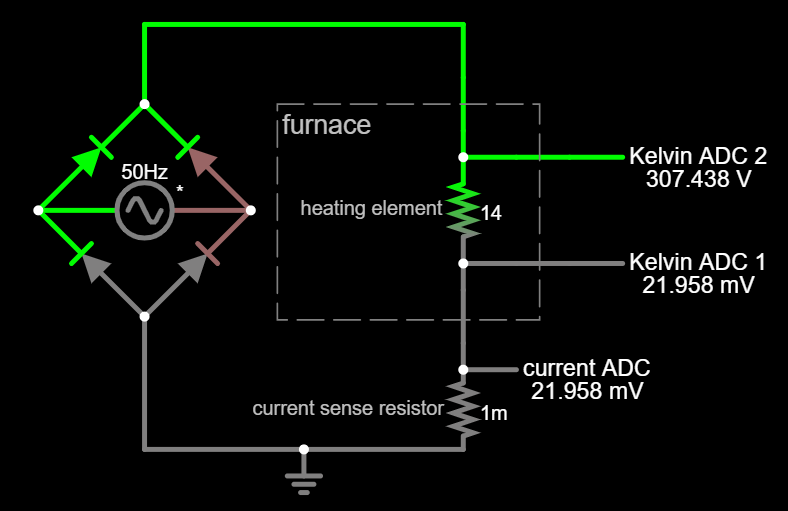Context
I'm making an electric furnace for melting metal, and aiming to make my own controller.
Everyone seems to just use thermocouples and a control loop, I thought perhaps I could just measure the resistivity from the heating element. I'm planning on using Kanthal A-1 (rated for 1400°C/2552°F) at temperatures that can reach 1200°C/2192°F. Highest temperature thermocouples I've been able to find were 1250°C/2282°F which is a bit too close for comfort.. a control loop overshoot may kill it and then.. kanthal isn't cheap.
Current Thinking
Now while kanthal has a quite low tempco of ~50ppm/°K, we're talking about a big delta here and precision in the single digits isn't required, so I think it could work. Calibration could be done with the thermocouple.
Since I'm aiming for somewhere around 3-4kw, I was thinking of just rectifying some mains AC, and using 3 ADCs to take the resistivity reading.
Here's the rough idea (the 'notches' represent runs of wire between the furnace and the controller):


(The switching mechanism for controlling the temperature just isn't drawn, I'm not forgetting it needs to exist).
ADC for this doesn't need to be fast, 100Ksps will give me 1000 readings per every cycle (though I'm thinking 1Msps for switching headroom). And for a 16-bit adc, the 4% change in resistivity over the full temperature swing still gives me a range with 2^16 x 0.04 ≈ 2621 values - about half a degree celsius per increment.
To take the kelvin reading, I'm thinking of using kanthal leads. That way they won't melt. Just tig weld them near the ends of the heating element on the inside of the furnace. The point at which they reach the controller should be ambient temperature, so thermal EMF issues are avoided too.
There are a couple vishay 20ppm/°K 1mΩ shunts for very cheap on mouser, so even though we're talking high currents I think very good precision can be achieved. Could also use multiple, use a heatsink, or even do both.
At 20ppm/°K, in the eggagerated scenario of a 40°C temperature rise we get 20/1,000,000*40 = 0.0008 ≈ 0.1%. That would be 1/40 of that 4% resistivity change.
Wind-Up
I realize this has more possible points of failure than the typical implementation - reading a thermocouple and running a PID loop is tried, tested and rhobust. I'm not asking whether this is the simplest solution to my problem as I know it isn't.
But it does seem the most reasonable for the resources I have at my disposal.
So, provided what I wrote above is right (and please, tell me if it's not), is this sensible? Or is there something I'm missing?
